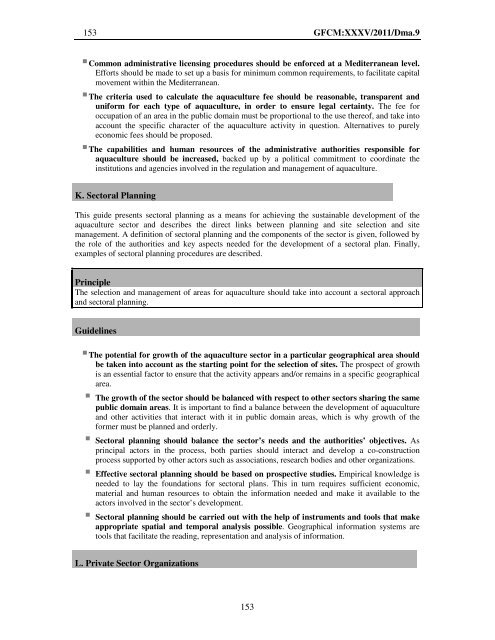Site selection and carrying capacity in Mediterranean ... - FAO Sipam
Site selection and carrying capacity in Mediterranean ... - FAO Sipam
Site selection and carrying capacity in Mediterranean ... - FAO Sipam
You also want an ePaper? Increase the reach of your titles
YUMPU automatically turns print PDFs into web optimized ePapers that Google loves.
153 GFCM:XXXV/2011/Dma.9<br />
Common adm<strong>in</strong>istrative licens<strong>in</strong>g procedures should be enforced at a <strong>Mediterranean</strong> level.<br />
Efforts should be made to set up a basis for m<strong>in</strong>imum common requirements, to facilitate capital<br />
movement with<strong>in</strong> the <strong>Mediterranean</strong>.<br />
The criteria used to calculate the aquaculture fee should be reasonable, transparent <strong>and</strong><br />
uniform for each type of aquaculture, <strong>in</strong> order to ensure legal certa<strong>in</strong>ty. The fee for<br />
occupation of an area <strong>in</strong> the public doma<strong>in</strong> must be proportional to the use thereof, <strong>and</strong> take <strong>in</strong>to<br />
account the specific character of the aquaculture activity <strong>in</strong> question. Alternatives to purely<br />
economic fees should be proposed.<br />
The capabilities <strong>and</strong> human resources of the adm<strong>in</strong>istrative authorities responsible for<br />
aquaculture should be <strong>in</strong>creased, backed up by a political commitment to coord<strong>in</strong>ate the<br />
<strong>in</strong>stitutions <strong>and</strong> agencies <strong>in</strong>volved <strong>in</strong> the regulation <strong>and</strong> management of aquaculture.<br />
K. Sectoral Plann<strong>in</strong>g<br />
This guide presents sectoral plann<strong>in</strong>g as a means for achiev<strong>in</strong>g the susta<strong>in</strong>able development of the<br />
aquaculture sector <strong>and</strong> describes the direct l<strong>in</strong>ks between plann<strong>in</strong>g <strong>and</strong> site <strong>selection</strong> <strong>and</strong> site<br />
management. A def<strong>in</strong>ition of sectoral plann<strong>in</strong>g <strong>and</strong> the components of the sector is given, followed by<br />
the role of the authorities <strong>and</strong> key aspects needed for the development of a sectoral plan. F<strong>in</strong>ally,<br />
examples of sectoral plann<strong>in</strong>g procedures are described.<br />
Pr<strong>in</strong>ciple<br />
The <strong>selection</strong> <strong>and</strong> management of areas for aquaculture should take <strong>in</strong>to account a sectoral approach<br />
<strong>and</strong> sectoral plann<strong>in</strong>g.<br />
Guidel<strong>in</strong>es<br />
The potential for growth of the aquaculture sector <strong>in</strong> a particular geographical area should<br />
be taken <strong>in</strong>to account as the start<strong>in</strong>g po<strong>in</strong>t for the <strong>selection</strong> of sites. The prospect of growth<br />
is an essential factor to ensure that the activity appears <strong>and</strong>/or rema<strong>in</strong>s <strong>in</strong> a specific geographical<br />
area.<br />
The growth of the sector should be balanced with respect to other sectors shar<strong>in</strong>g the same<br />
public doma<strong>in</strong> areas. It is important to f<strong>in</strong>d a balance between the development of aquaculture<br />
<strong>and</strong> other activities that <strong>in</strong>teract with it <strong>in</strong> public doma<strong>in</strong> areas, which is why growth of the<br />
former must be planned <strong>and</strong> orderly.<br />
Sectoral plann<strong>in</strong>g should balance the sector’s needs <strong>and</strong> the authorities’ objectives. As<br />
pr<strong>in</strong>cipal actors <strong>in</strong> the process, both parties should <strong>in</strong>teract <strong>and</strong> develop a co-construction<br />
process supported by other actors such as associations, research bodies <strong>and</strong> other organizations.<br />
Effective sectoral plann<strong>in</strong>g should be based on prospective studies. Empirical knowledge is<br />
needed to lay the foundations for sectoral plans. This <strong>in</strong> turn requires sufficient economic,<br />
material <strong>and</strong> human resources to obta<strong>in</strong> the <strong>in</strong>formation needed <strong>and</strong> make it available to the<br />
actors <strong>in</strong>volved <strong>in</strong> the sector’s development.<br />
Sectoral plann<strong>in</strong>g should be carried out with the help of <strong>in</strong>struments <strong>and</strong> tools that make<br />
appropriate spatial <strong>and</strong> temporal analysis possible. Geographical <strong>in</strong>formation systems are<br />
tools that facilitate the read<strong>in</strong>g, representation <strong>and</strong> analysis of <strong>in</strong>formation.<br />
L. Private Sector Organizations<br />
153
















